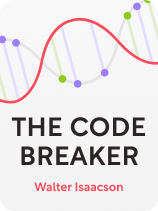

This article is an excerpt from the Shortform book guide to "The Code Breaker" by Walter Isaacson. Shortform has the world's best summaries and analyses of books you should be reading.
Like this article? Sign up for a free trial here.
Who is Jennifer Doudna? How did she develop CRISPR technology, and how did the breakthrough launch her career?
Jennifer Doudna’s journey from a curious child in Hawaii to a Nobel Prize-winning scientist is nothing short of inspiring. Her work on CRISPR, alongside colleague Emmanuelle Charpentier, has transformed the field of gene editing and opened up new possibilities in medicine and biotechnology.
Read on to discover how Doudna’s early experiences shaped her career, the challenges she faced as a woman in STEM, and the intense competition that surrounded the development of CRISPR technology.
Doudna’s Early Life and Career
Who is Jennifer Doudna? She was born in 1964 and spent the majority of her childhood in Hawaii. Because she was in the minority of white children there, she felt like an outsider, and she took refuge in Hawaiian nature. Isaacson explains that two adults in Doudna’s life nurtured her fascination with nature: A friend of her parents, who was a biologist, taught her some scientific basics during nature walks, and her father gave her a copy of The Double Helix (the story of how scientists Crick, Watson, and Franklin discovered the structure of DNA). The book excited Doudna for two reasons: First, it inspired her to investigate why the world worked as it does. Second, it taught her that despite what her teachers said, women could be scientists.
Jennifer Doudna majored in chemistry at Pomona College and went to graduate school at Harvard University. Isaacson explains that at the time, most biologists were preoccupied with studying DNA because they thought it was the next scientific frontier. However, Doudna’s advisor at Harvard encouraged her to focus on RNA. Doudna began exploring ribozyme structure and function, which presaged her work with CRISPR. Then, as a postdoctoral researcher at the University of Colorado, she set out to discover why RNA could be used to edit genes. With the help of her labmate and future husband Jamie Cate, she mapped out RNA’s structure, which helped her understand how it worked.
(Shortform note: Early in her career, Doudna told a biographer that she was drawn to pure science over applied science—she researched RNA because she simply wanted to understand how it worked, not because her findings could prove practical (or even profitable) in the real world. She also said that she found RNA interesting because, according to the RNA World hypothesis, RNA may have existed as the first form of life on earth. Her interest in the origins and evolution of life contributed to her decision to begin working with CRISPR, as she explains in her book A Crack in Creation. As we’ll discuss, despite her devotion to pure science, her CRISPR-related research eventually opened her up to the world of applied science.)
Isaacson explains that with these discoveries under her belt, Doudna was officially an expert on RNA. The University of California at Berkeley offered her a professorship, and she continued to research RNA in that capacity. There, she focused on RNA interference—a process that she hypothesized could be used for gene editing. Doudna’s research on gene editing took a different turn than she expected, though: When a colleague suggested that she apply her RNA expertise to CRISPR, she tasked her lab with learning how Cas enzymes worked by determining their structure. Once they accomplished that, Doudna moved onto groundbreaking research—she teamed up with Charpentier to clarify how the CRISPR-Cas system works.
(Shortform note: RNA interference, also known as RNAi, is a mechanism by which certain cells silence, or prevent the expression of, certain genes. RNAi has therapeutic applications, like silencing the genes responsible for some forms of cancer, but it isn’t used for gene editing. That’s because RNAi targets mRNA transcripts (copies of DNA) rather than the original genes encoded in DNA, resulting in temporary changes. On the other hand, gene editing tools, which include CRISPR and other technologies, target DNA directly, resulting in permanent genetic changes.)
| Women in STEM Must Overcome Unique Challenges In tracing Jennifer Doudna’s career back to her childhood experiences, Isaacson underscores an important truth about how women enter STEM (science, technology, engineering, and math) fields: Positive childhood STEM experiences are paramount, especially for people whose identities are underrepresented in STEM—including women. Experts have identified a lack of female role models in STEM as a barrier to girls’ entry into the field, and studies suggest that supplying girls with role models enhances their STEM competencies and interests. Altogether, these facts may explain why Doudna was inspired by early exposures to science, by Franklin’s role in The Double Helix, and by other female role models throughout her career. Once a woman overcomes initial barriers to STEM entry, including limited access to female role models in childhood, she may still face challenges within the field on account of her gender. For example, experts say that despite some progress toward gender equality, women in STEM change careers more often than men do (which disrupts traditional trajectories of success). This could be due to what’s known as the motherhood penalty—pressure professional women experience to choose between having a career or having children. Marriage can also harm women’s career prospects in STEM if they don’t have supportive partners. Doudna has spoken about how her husband’s support has helped her achieve a healthy work-life balance. |
Doudna Developed CRISPR Technology Alongside Colleagues & Competitors
Isaacson explains that, after Jennifer Doudna helped discover how CRISPR-Cas9 works in nature, she focused on developing the system into a technology for human use. Doudna played a huge role in the development of CRISPR technology, but she didn’t do it alone—both colleagues and competitors helped her establish this scientific innovation. Let’s discuss the contributions each key player made toward the advent of CRISPR technology.
Doudna Collaborates With Charpentier
Around the same time that Doudna began researching Cas enzymes, other scientists were conducting experiments aimed at preventing viral infections in the bacteria used to make yogurt. They discovered that they could insert CRISPR elements into bacterial cells instead of waiting for cells to naturally develop CRISPR-derived immune defenses. The scientists also confirmed that cells’ CRISPR defenses were inheritable. Based on this discovery, the scientific community concluded that it could potentially use CRISPR to create inheritable alterations to any type of gene.
Doudna and Charpentier turned this potentiality into an actuality, writes Isaacson. They realized that, since crRNA determined which genes to cut out of a virus, they could use different versions of crRNA with different targets to edit any segment of DNA they wanted. To simplify this process, they fused together crRNA and tracrRNA to create sgRNA (single-guide RNA) in 2013. The invention of sgRNA transformed CRISPR from a biological process into a gene editing tool. They experimented with single-celled organisms and proved that they could edit genes at will. Isaacson explains that other gene editing tools already existed, but CRISPR gene editing technology quickly displaced them because it was more straightforward and efficient.
Doudna Competes With Zhang (and Other Scientists)
Isaacson explains that, although Doudna and Charpentier successfully demonstrated that they could edit the genes of single-celled organisms, it wasn’t immediately clear that the same process could be used in more complex cells (like human cells). As soon as Doudna and Charpentier published their paper on CRISPR gene editing technology, scientists around the world began competing to become the first to use it in human cells. Doudna’s primary competitor in this race was Feng Zhang, a Harvard-educated biochemist with expertise in earlier forms of gene editing technology.
Zhang says that he independently figured out how CRISPR works and used it to edit human and mouse cells by the middle of 2012. But Isaacson explains there are two reasons not to give Zhang credit for the invention of CRISPR gene editing technology: First, according to Zhang’s own records, he didn’t understand how important Cas9 and tracrRNA were to the CRISPR process; Doudna and Charpentier definitely made that discovery. Second, Zhang didn’t create sgRNA (the synthetic molecule that transformed CRISPR from a natural process into a technology)—Doudna and Charpentier did. However, Zhang disagrees that sgRNA is integral to the technology, and Doudna’s lab discovered that sgRNA doesn’t work well for editing human cells.
According to Isaacson, the race to optimize CRISPR gene editing technology for human cells was close. Zhang made modifications to the original version of sgRNA that Doudna and Charpentier developed. His paper was published the same day as another scientist’s paper, and the other scientist’s modifications to sgRNA proved more suitable for human DNA editing than Zhang’s. Later the same month, Doudna published her own paper, which demonstrated another way to apply CRISPR to human cells. Two other scientists published papers on the same topic that year. Since multiple scientists made significant contributions to the application of CRISPR gene editing technology in human cells, it was difficult to say who invented the process.
The War for Patent Rights and Recognition
Isaacson explains that both academia and the biotechnology industry are extremely competitive. In academia, being the first to make a discovery leads to greater prestige and career success. In the biotechnology industry, being first enables you to develop patents.
The competitive nature of scientific research—and the ambiguity surrounding who truly invented the process for human gene editing—led Doudna, Charpentier, and Zhang to become embroiled in a war for patent rights and recognition. Let’s explore how that played out.
In 2013, Doudna, Zhang, and other scientists established a CRISPR-focused medical research company together called Editas Medicine. However, Doudna left the company a few months later due to a conflict: Doudna and Charpentier had applied for a patent together, as had Zhang and his team. Zhang paid to accelerate the application process, so he was granted the patent for CRISPR first. Isaacson says that Doudna felt this was unfair: She believed she and Charpentier were the first to develop the technology, and she thought Zhang’s actions were underhanded and proved him untrustworthy. She left Editas Medicine to join Intellia, an offshoot of a biotechnology company she’d built earlier in her career (Caribou Biosciences).
Meanwhile, conflict was also brewing between Doudna and Charpentier: Charpentier viewed herself as the primary researcher who discovered CRISPR technology, while Doudna felt it was a joint project for which she was entitled equal recognition. Due to this conflict, Charpentier formed her own biotechnology company instead of joining Doudna (or Zhang).
Nevertheless, Doudna and Charpentier were jointly awarded several prizes for their work on CRISPR. Isaacson explains that these prizes affirmed two things: Doudna and Charpentier had made relatively equal contributions, and despite Zhang’s patent approval, they were the first to discover the technology. These affirmations were echoed by the greater scientific community when one of Zhang’s associates published an article lauding Zhang for his contributions to the discovery. Critics of the article argued that the article’s writer ignored Doudna’s contributions because he was sexist, which led to a Twitter firestorm.
Isaacson explains that, since their application was still being processed when Zhang’s patent was awarded, Doudna and Charpentier were legally entitled to continue fighting for patent rights. They argued in court that they deserved the patent because they were the first to develop CRISPR gene editing technology and to say that it could be used in human cells. Zhang countered that he deserved the patent because Doudna and Charpentier’s original version of sgRNA didn’t work in humans and his innovation solved that problem. The US Patent Office determined Zhang should have the patent after all, but Doudna and Charpentier won other patent wars abroad, in nations like Mexico, China, New Zealand, and Japan.
How CRISPR Launched Doudna’s Career
Isaacson explains that, despite her loss in the war for US patent rights, Jennifer Doudna’s career has benefited tremendously from her contributions to CRISPR science and technology. He focuses on two primary benefits: First, Doudna entered the biotechnology industry. She started her own company (Caribou Biosciences), briefly worked for Editas Medicine with Zhang, and then returned to Caribou by joining its offshoot, Intellia. She then founded a research nonprofit (the Innovative Genomics Institute or IGI) and a company called Mammoth Biosciences, which both played an important role in the fight against Covid-19.
(Shortform note: Biotechnology is a lucrative industry—made more lucrative by the invention of CRISPR—that spans healthcare, environmental, and industrial research applications. As of 2023, Caribou Biosciences had made major advances toward using CRISPR against blood cancers, Editas Medicine had an ongoing clinical trial for CRISPR-derived sickle cell disease treatment, Intellia had an ongoing clinical trial for CRISPR therapies for ATTR amyloidosis (a rare disease that can result in heart failure), the IGI is researching CRISPR cures for environmental and agricultural issues and world hunger, and Mammoth Biosciences is researching CRISPR’s diagnostic applications, including tools that can detect cancer and viral or bacterial infections.)
Second, Doudna and Charpentier were jointly awarded the Nobel Prize in Chemistry in 2020 for their research on CRISPR. Isaacson explains that their victory was historic for a few reasons. First, it usually takes decades for the Nobel Prize Committee to reward contributions to science. Second, there were only two recipients instead of the usual three—which means the committee decided that Zhang and other competitors were less deserving of credit for CRISPR gene editing technology. Finally, for the first time, all the recipients were women (and only five of nearly 200 previous recipients in history had been women). Doudna and Charpentier agreed that this was a monumental win for women and hoped it would inspire girls to pursue science.
(Shortform note: Experts say that Doudna and Charpentier were awarded the Nobel Prize more quickly than usual because their invention had clear potential to change the world; most discoveries and inventions that are awarded the Nobel Prize aren’t quite so groundbreaking. Experts also believe that women receive fewer Nobel Prizes in science than men because of the unique challenges women face in STEM careers—and perhaps also because of implicit bias against women on the part of those responsible for recognizing researchers’ most notable achievements. As for why Zhang wasn’t recognized by the Nobel Prize Committee, the committee’s chairman declined to comment.)

———End of Preview———
Like what you just read? Read the rest of the world's best book summary and analysis of Walter Isaacson's "The Code Breaker" at Shortform.
Here's what you'll find in our full The Code Breaker summary:
- The fascinating story of the groundbreaking CRISPR gene editing technology
- Why CRISPR presents scientists and citizens with serious moral quandaries
- How CRISPR has already changed life as we know it—and how it has the potential for even more






